Hey there, fellow dog aficionados! 👋
Are you constantly amazed by the fascinating ways our canine companions 🐕communicate with us?
Winston, my loveable 3-year-old black labrador, like many dogs, has his own set of adorable and sometimes baffling behaviors – from his food-inhaling abilities 🍖 to his park zoomies with his buddies.
It’s these little quirks that make them so endlessly endearing, isn’t it?
But have you ever stopped to wonder why they do the things they do? 🤔
Well, you’re in for a treat because today, we’re going to unravel 10 fascinating doggy curiosities that will make you see your furry friend in a whole new light! ✨
Trust me, by the end of this, you’ll be practically fluent in “Dog”! 😉
Ready to become a canine behavior whiz?
Let’s jump right in!
The Post-Potty Paw Scratch: Territory Marking 101
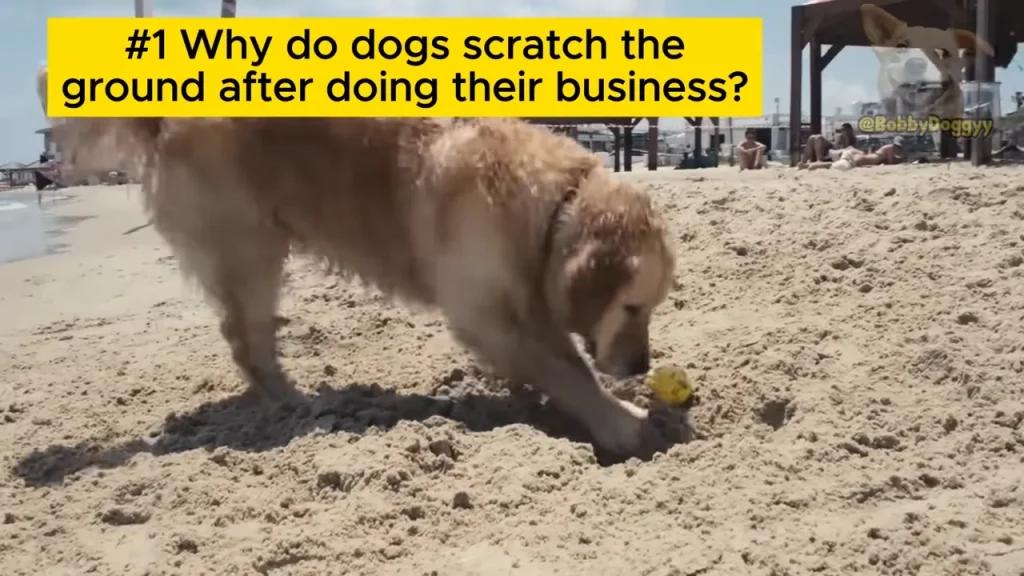
Ever watched your dog do their business, and then… BAM!
They launch into a furious scratching session with their back paws? 🐾
It’s a classic dog move, right?
Every dog owner has witnessed this post-potty ritual.
They poop or pee, and then suddenly, they’re scratching at the ground like they’re trying to bury treasure… or maybe hide evidence! 😂
But guess what?
It’s not about burying anything at all!
This behavior is actually way more complex than just a quirky habit.
In fact, it’s all about communication… canine style! 💌
It’s about spreading pheromones, those invisible chemical messages dogs use to “talk” to each other.
Clever, huh? These pheromones are released from glands located in their paws.
So, when they scratch, they’re not just making a mess on your lawn… they’re leaving a scent-based memo for all the neighborhood dogs to sniff out! 📝
These pheromones act as chemical messages for other dogs, signaling that “Hey, this territory is already taken!”
It’s like a canine “Do Not Enter” sign, but way more subtle… and smelly! 😉
And it’s not just about the smell…
The scratching itself also leaves visual clues…
Additionally, the act leaves visible marks, further reinforcing the message.
Think of it as a double whammy of doggy communication – scent and sight!
It’s like saying, “I was here, and I’m claiming this spot!” loud and clear… well, in dog language anyway! 🗣️
This instinctive behavior comes from their wolf ancestors, who use the same technique to protect their spaces and warn other animals.
Pretty cool to think about our pampered pooches sharing these ancient instincts with their wild cousins, isn’t it?
Fascinating, isn’t it? 🤔
Tail-Chasing Fun: Playtime or Something More?
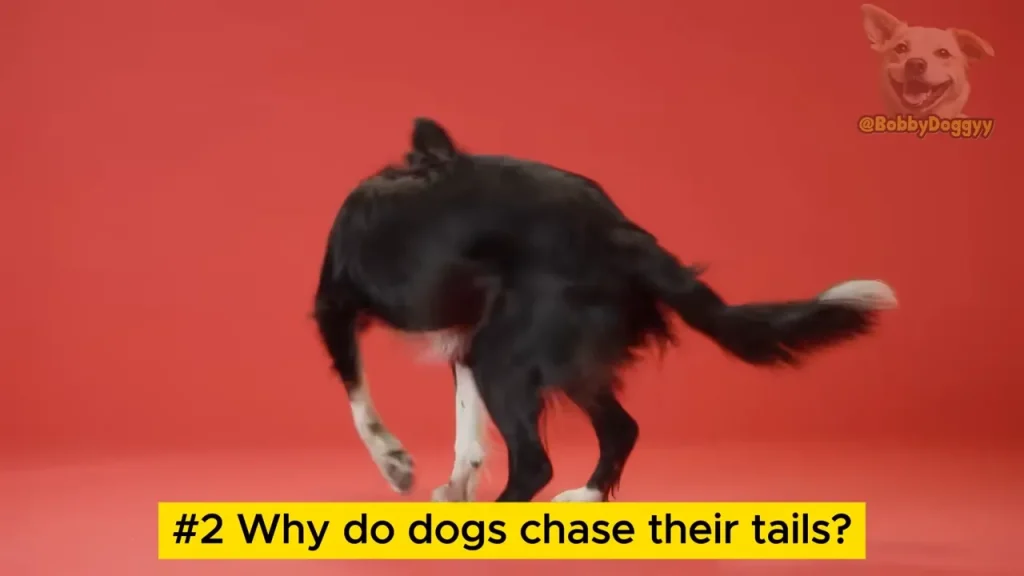
Now, who hasn’t chuckled at the sight of a dog spinning in circles, tail in hot pursuit? 🤪
Who hasn’t laughed watching a dog spin around madly chasing its own tail?
It’s pure comedy gold, right?
They look so determined, so focused on catching that elusive furry appendage! 😂
And while it’s definitely entertaining to watch, there’s actually more to this behavior than just slapstick silliness.
Believe it or not, tail-chasing can have several interesting explanations.
Let’s dive in, shall we? 🤿
For puppies, it’s often simply a form of play and exploration…
For puppies, it’s just a playful way to explore their bodies.
They’re discovering their own anatomy, figuring out what this wiggly thing attached to their rear end is all about! It’s all part of puppyhood, learning about themselves and their capabilities.
Think of it as puppy yoga… but much more chaotic! 🧘♀️
But what about adult dogs? Is it still just playtime for them? …
Well, sometimes, but not always.
In adult dogs, tail-chasing can signal a few different things…
But in adult dogs, it can be a sign of pent-up energy, boredom, or even stress.
If your adult dog is suddenly Mr. (or Ms.) Twister, it might be their way of saying, “Hey, I need something to do!”
They might be feeling restless, under-stimulated, or even a bit anxious.
It’s their way of trying to release that energy and entertain themselves when things are a bit… well, blah. 😔
And in some cases, it might even be a sign of a physical issue.
In more serious cases, tail-chasing could be a sign of a medical condition…
In more serious cases, it could indicate conditions like allergies or tail irritation.
If your dog is obsessively chasing their tail, especially if it seems frantic or distressed, it’s always a good idea to check in with your vet.
They can rule out any underlying medical reasons for the behavior, such as skin allergies, fleas, or even an injury to the tail itself.
Better safe than sorry, right? 😉
And get this… environment plays a role too!
Studies have even shown a link between environment and tail-chasing…
Studies also show that dogs living in low-stimulation environments are more likely to develop this behavior as a compulsive activity.
Dogs are smart cookies 🍪, and they need mental and physical stimulation to thrive.
If they’re not getting enough to keep their minds and bodies busy, they might resort to tail-chasing as a way to fill the void.
Think of it as canine cabin fever! 🏠
So if it happens frequently, consider offering your dog more activities to keep them engaged.
More walks, more playtime, more puzzle toys… a little extra enrichment can go a long way in keeping your dog happy and healthy, both mentally and physically! 😊
Zoomies: The Frenzy of Fun!
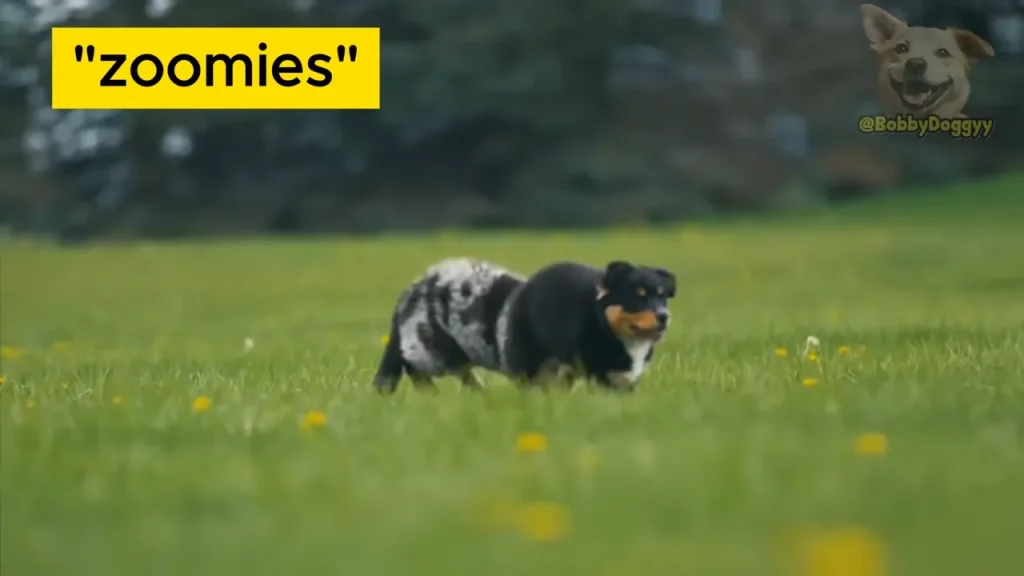
Ever witnessed your dog suddenly transform into a furry tornado, tearing through the house or yard like a bat out of… well, you know? 🦇💨
Have you ever seen your dog running like crazy around the house or yard for no apparent reason?
One minute they’re calmly sniffing the roses, the next they’re a blur of fur and four paws! 😂
This hilarious burst of energy is known as the zoomies, or, if you want to get fancy, frenetic random activity periods, or FRAPs.
Whatever you call it, it’s a sight to behold!
And guess what? It’s actually a good thing! 👍
This behavior known as zoomies or frenetic random activity periods (FRAPs) is actually a healthy release of stored-up energy.
Think of it like shaking a soda bottle – eventually, that pressure needs to be released!
Zoomies are your dog’s way of letting off steam, burning off excess energy, and just generally having a blast.
It’s pure, unadulterated canine exuberance! 🎉
And when are zoomies most likely to strike?
It occurs mostly in young dogs or during moments of great excitement, like after a bath or in the evening.
Puppies, with their boundless energy, are zoomie pros!
But even adult dogs can get the zoomies, especially when they’re feeling extra happy or stimulated.
A bath, for example, might trigger a post-bath zoomie frenzy as they try to dry off and shake off the indignity of being squeaky clean! 😂
And those evening zoomies?
Often just a way to unwind and release energy before settling down for the night. 🌙
But zoomies aren’t just about burning energy…
Besides being a way to let loose, zoomies help dogs relax and keep their minds balanced.
It might seem counterintuitive – all that frantic running to relax?
But it works! Zoomies are a natural stress reliever for dogs, a way to shake off tension and just be silly and carefree.
It’s like canine meditation… in motion! 🧘🐕
So when it happens, enjoy their happiness and make sure the area is safe for them to run freely.
Clear the coffee table, move the breakables, and let your dog unleash their inner zoomie monster!
Just make sure they have a safe space to run wild and get their sillies out. 😉
The Happy Jump: “I’m SO Glad to See You!”
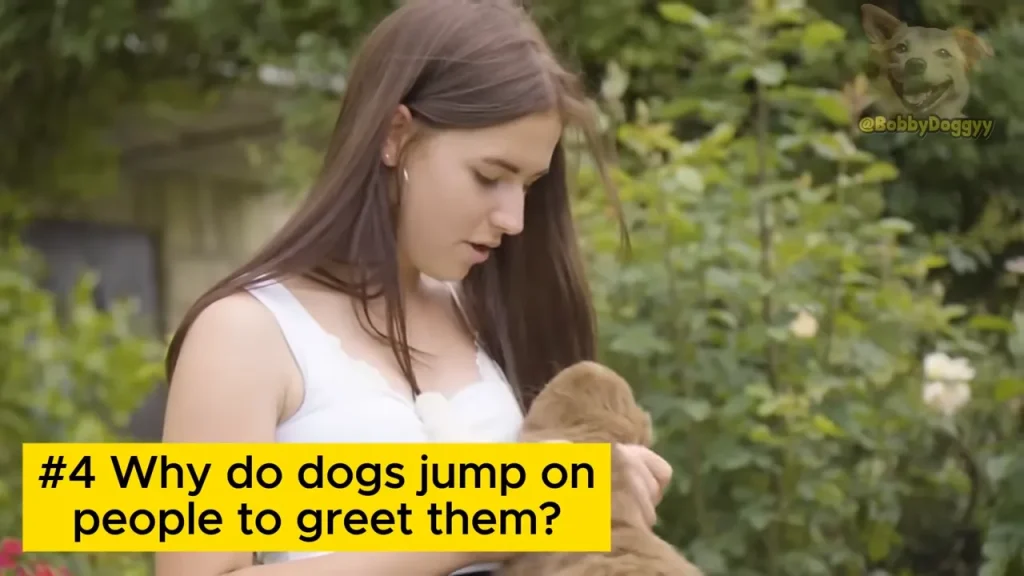
Ah, the classic doggy greeting – the happy jump! 🐾
The classic Happy Jump is something all dog owners recognize.
You walk in the door, and suddenly, you’re being greeted by a furry missile launching themselves at your legs (or sometimes, a little too enthusiastically, at your chest! 😅).
It’s a move that can be both heartwarming and… well, a little bit clumsy!
But why do they do it? Is it just pure excitement, or is there something more to this jumpy jamboree?
Let’s investigate! 🕵️♀️
Dogs do this because in nature, puppies lick the faces of adults to get attention or food.
Think back to their puppy days… tiny pups would instinctively lick their mom’s face to beg for food and attention.
It’s a deeply ingrained behavior, a way of saying, “Hey, notice me! I’m here, and I need something!”
And guess what?
They carry that behavior right into adulthood!
Even though you’re probably not going to regurgitate dinner for them (hopefully! 😂), the instinct remains.
And they bring this behavior into their interactions with humans.
We’re their pack now, their family, their everything!
So, naturally, they use the same greeting behaviors on us that they would use on other dogs.
It’s their way of showing us we’re part of their “in-group,” their beloved pack. Aww! 🥰
Since we’re taller, they jump to reach our faces and show affection.
Makes sense, right? We’re up here, they’re down there… a little jump is just their way of bridging the height gap and getting closer to our faces for those all-important licks and nuzzles!
It’s their way of saying, “I love you, and I want to be right there with you!” ❤️
And it’s not just about affection…
Additionally, jumping is their way of saying “I’m so happy I can’t contain myself!”
Pure, unadulterated joy!
That’s what that jump is all about.
They’re so thrilled to see you, so overcome with happiness, that they just have to express it physically!
It’s like their bodies are just bursting with excitement, and jumping is the only way to let it all out.
It’s a truly heartwarming display of canine enthusiasm! 😄
Now, while those happy jumps are adorable, sometimes, they can be a bit… much, especially for little kids or elderly folks.
So, what can you do if you want to tone down the jumpiness?
If you’d like to train your dog to greet people more calmly, use positive reinforcement.
Training is key!
You can teach your dog alternative greetings, like sitting or staying, and reward them with treats and praise when they greet people politely.
Consistency is crucial, and patience is a virtue! 😉
But remember, for them, it’s just another way to show love.
At its heart, that jump is a gesture of affection, a sign that your dog adores you and is overjoyed to see you.
So, even if you’re working on calmer greetings, remember to appreciate the love behind the jump! 💖
Poop Eating Puzzler: Coprofagia Explained
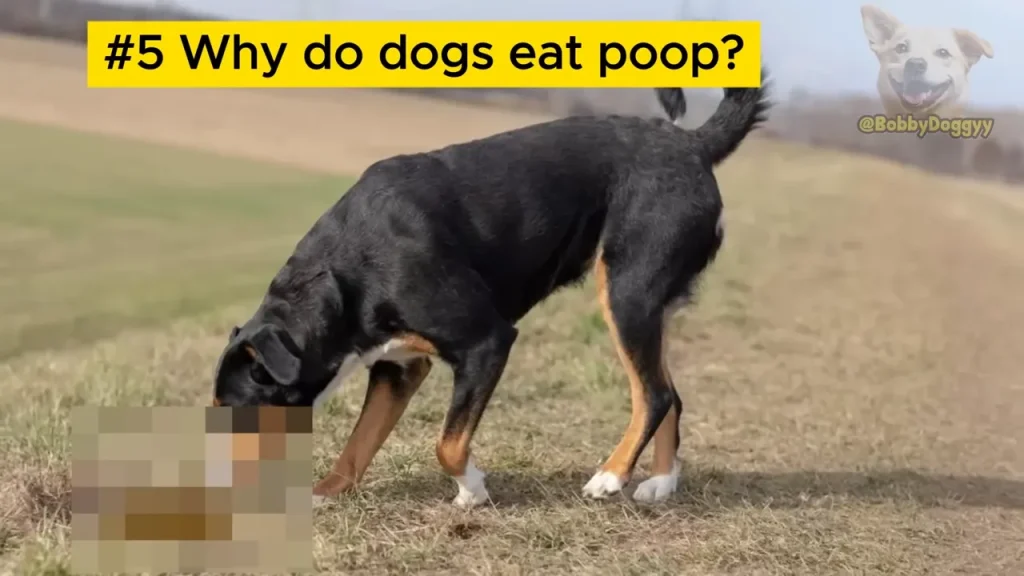
Okay, let’s talk about a behavior that might make some of us cringe… dog poop-eating! 🙈
Why do dogs eat poop? Coprophagia, as strange as it seems, is a common behavior among dogs.
Yep, you read that right.
Dogs sometimes eat… well, poop.
It’s definitely not the most glamorous of canine habits, and it can be pretty off-putting for us humans!
But before you wrinkle your nose in disgust, let’s try to understand why some dogs engage in this less-than-appetizing behavior.
There are actually a few reasons behind it, and some are more surprising than others!
Ready to delve into the world of canine coprophagia?
Let’s go! 🤢
For puppies, it’s often just part of exploring their world…
For puppies, it might just be an exploratory phase.
Puppies are curious little creatures, and they explore the world with their mouths – just like human babies!
They mouth things, chew things, and yes, sometimes, they might even sample things we’d rather they didn’t!
It’s all part of their learning process, figuring out what’s what in their new environment.
Think of it as puppy taste-testing… gone slightly awry! 😂
But what about adult dogs?
Surely, they know better, right? …
Well, it’s not always that simple.
But for adult dogs, the reasons vary.
It’s not always just about curiosity in grown-up dogs.
There can be several underlying reasons why an adult dog might develop a taste for poop.
Some are behavioral, some are dietary, and some are… well, just plain doggy! 😉
Some do it out of curiosity, while others might be seeking nutrients missing from their diet.
Yep, nutritional deficiencies can actually play a role in coprophagia.
If a dog’s diet is lacking in certain vitamins or minerals, they might instinctively try to compensate for those deficiencies by eating feces.
It’s not exactly a balanced meal, but their bodies might be craving something they’re not getting elsewhere. 🤔
And get this – even cleanliness can be a factor!
Interestingly, studies show that dogs living in extremely clean environments are less likely to develop this habit.
Huh? Cleanliness reduces poop eating?
It sounds backwards, doesn’t it?
But the theory is that in super-clean environments, dogs might be less exposed to the natural bacteria and enzymes found in feces, and therefore, less likely to develop a taste for it. It’s a bit of a head-scratcher, but there you have it! 🤷♀️
Additionally, some mother dogs eat their puppy feces to keep the area clean.
This is a natural, maternal instinct.
Mama dogs clean up after their pups to keep the nest clean and prevent predators from being attracted to the scent. It’s all part of being a good doggy mom! 💖
Now, while coprophagia might be “normal” for some dogs, it’s definitely not something we want them doing.
So, what should you do if your dog is a poop-eating connoisseur?
If your dog exhibits this behavior, it’s worth investigating their diet and environment.
First things first, talk to your vet!
They can help rule out any underlying medical issues or nutritional deficiencies.
They might recommend a diet change or supplements to ensure your dog is getting all the nutrients they need.
And of course, good poop-scooping habits are essential! 😉 Keeping your yard and home clean can help discourage the habit.
While it might be a bit gross, understanding why dogs eat poop can help us address the issue and keep our furry friends healthy and happy! 😊
Belly Up Sleeping: The Ultimate Trust Signal
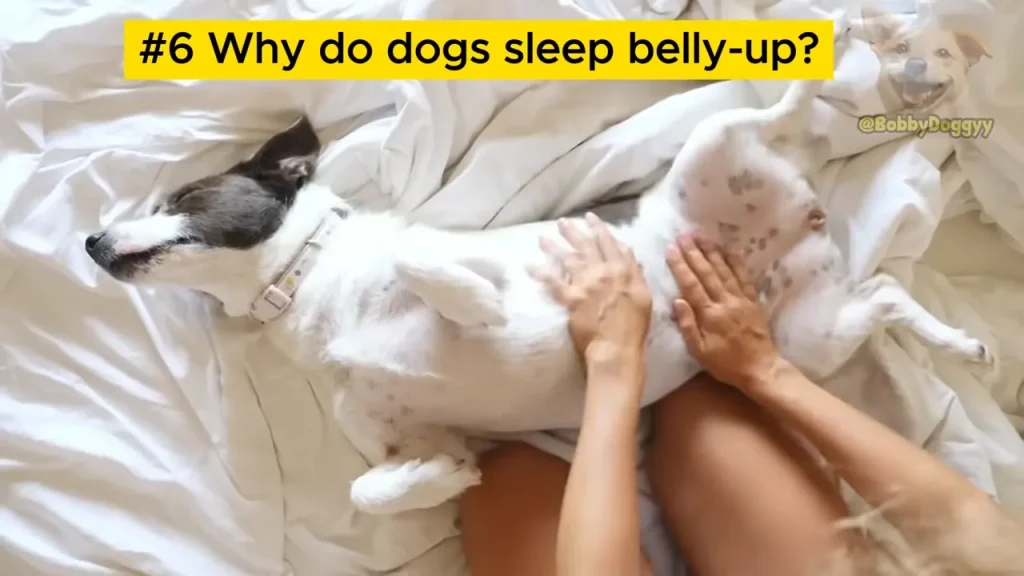
Ever caught your dog snoozing on their back, paws splayed out in the air, belly fully exposed? 🐾
When a dog sleeps belly up with their paws in the air, they’re showing total relaxation and trust.
It’s a pretty comical sight, isn’t it?
They look so vulnerable, so completely at ease.
But that’s exactly what it is – a huge compliment!
This belly-up sleeping position is actually a major sign of trust and comfort.
Want to know why?
Let’s break it down! 👇
This position is highly vulnerable because it exposes their vital organs.
Think about it – their belly is soft, unprotected, and contains all sorts of important bits and pieces!
In the wild, a dog would never sleep in this position unless they felt absolutely, completely safe.
It’s a sign of utter vulnerability, a total surrender to their surroundings.
But dogs only adopt it when they feel completely safe in their environment and with the people around them.
And that “people around them” part?
That’s you!
If your dog is belly-up snoozing around you, it means they trust you implicitly.
They feel secure, protected, and loved in your presence.
Talk about a warm fuzzy feeling! 🥰
And it’s not just about trust…
Additionally, sleeping this way helps regulate body temperature, since the belly has less fur.
Yep, there’s a practical reason behind the belly-up snooze too!
Dogs can get warm, especially when they’re all snuggled up in their fur coats.
Exposing their belly to the air helps them cool down and regulate their body temperature, especially on warmer days.
It’s like canine air conditioning! ❄️
It’s a clear sign that they trust you completely and feel comfortable at home.
So, next time you see your dog belly-up sleeping, take it as a huge compliment!
They’re telling you, in doggy body language, “I trust you, I love you, and I feel completely safe with you.” 💖
What could be sweeter than that? 😊
Sunbathing Bliss: Soaking Up the Rays
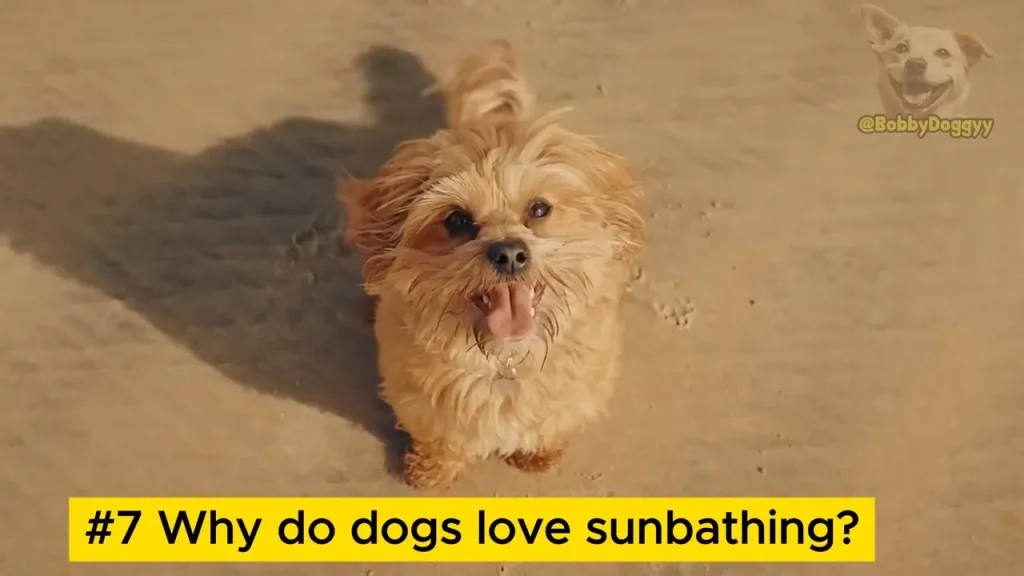
Have you ever noticed your dog strategically positioning themselves in the sunniest spot in the house, basking in the warm rays like a furry little sun worshipper? ☀️
Dogs love lying in the sun, and it’s more beneficial than it seems.
They seem to love soaking up those sunbeams, don’t they?
It looks so relaxing, so… blissful. And guess what? It’s not just about feeling cozy and warm.
Sunbathing actually has some real health benefits for our canine pals!
Let’s shine a light on the science behind doggy sunbathing! 💡
Sun exposure helps produce Vitamin D, essential for healthy bones and a strong immune system.
Just like humans, dogs need Vitamin D for their overall health and well-being.
And sunshine is a fantastic natural source of this vital vitamin! Vitamin D plays a crucial role in calcium absorption, which is essential for strong bones and teeth.
It also supports a healthy immune system, helping them fight off illness and stay in tip-top shape. 💪
So, that sunbathing session isn’t just a lazy dog indulgence; it’s actually a health boost!
And the benefits don’t stop there…
Additionally, the warmth relaxes muscles and relieves joint pain, especially in older dogs.
Ah, the soothing warmth of the sun… it’s not just good for our muscles and joints; it’s beneficial for our furry friends too!
The warmth from the sun can help ease muscle tension, soothe stiff joints, and provide relief from aches and pains, especially for senior dogs who might be feeling the effects of age and arthritis.
It’s like a natural doggy spa treatment, right in your backyard!
However, be cautious, prolonged exposure can lead to overheating or burns.
While sunbathing is good in moderation, too much of a good thing can be harmful.
Dogs can overheat in the sun, especially in hot weather, and they can even get sunburned, particularly on their noses and ears. Ouch! 🥵
Make sure your dog has access to shade and fresh water.
Always ensure your dog has a shady spot to retreat to if they get too hot, and always provide plenty of fresh, cool water to keep them hydrated.
Sunbathing is great, but safety first! 😉
Foot Licking Fascination: A Salty Affection?
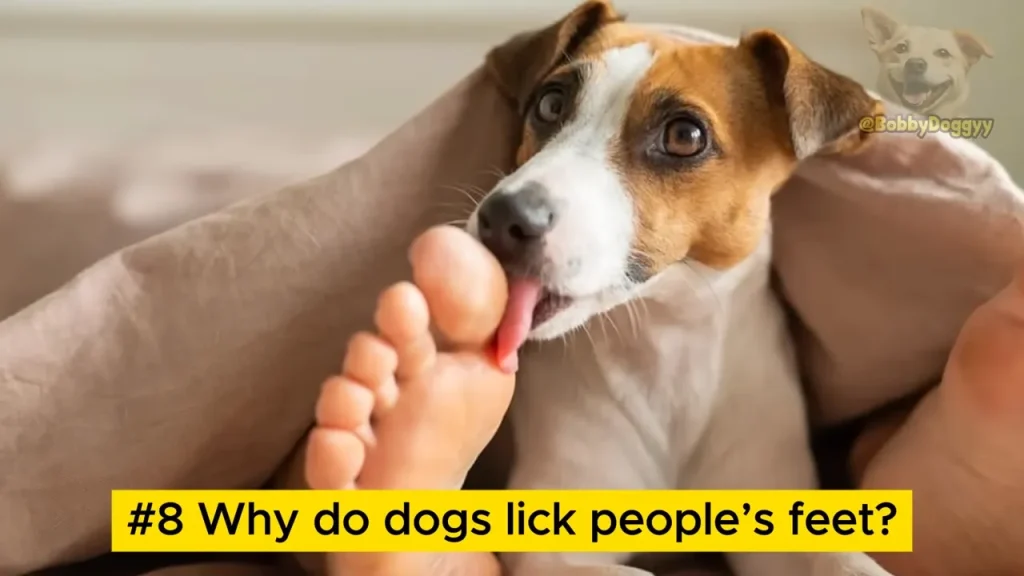
Okay, let’s get a little… personal for a moment.
Foot licking. Yep, some dogs are really into licking human feet. 🦶
Why do dogs lick people’s feet? This habit might seem strange, but for dogs, it’s a way of showing affection and respect.
It’s definitely a quirky one, right? It might seem a bit… odd to us humans, but for dogs, it’s actually a perfectly normal and even affectionate behavior.
But why feet? Of all the body parts, feet?
Let’s investigate this foot-focused fascination! 🔍
Human sweat glands release salts and other chemical compounds that dogs can detect through taste and smell.
Ah, the science of scent!
Dogs have incredible noses, and they can detect a whole world of smells that we humans are completely oblivious to.
And guess what?
Our feet are a veritable scent buffet for dogs!
Our sweat glands release salts and other yummy-smelling (to dogs, anyway! 😉) chemical compounds that are just irresistible to their super-sensitive noses and taste buds.
It’s like a salty, savory snack… for their noses and tongues!
Yum? 😅 And it’s not just about the taste and smell…
Moreover, licking is a form of communication and social interaction for them.
Licking isn’t just about taste; it’s also a way dogs bond with each other and with us.
It’s a social behavior, a way of showing affection, submission, and even seeking attention.
Think of it as canine social grooming, a way of strengthening bonds and showing they care. 💖
Some dogs lick feet as a way of exploring or even seeking attention, especially if they notice it gets a reaction from you.
And let’s be honest, foot licking does tend to get a reaction from us humans, doesn’t it? 😂
Whether it’s a giggle, a “Ewww, dog breath!”, or a gentle push away, our reaction reinforces the behavior.
If your dog has figured out that foot licking gets them attention, they might just keep doing it!
So, foot licking might be a little… unconventional in our human eyes, but for dogs, it’s often a sign of affection, communication, and maybe just a little bit of salty snacking! 😉
Gentle Nibbles: “I Like This, Keep Going!”
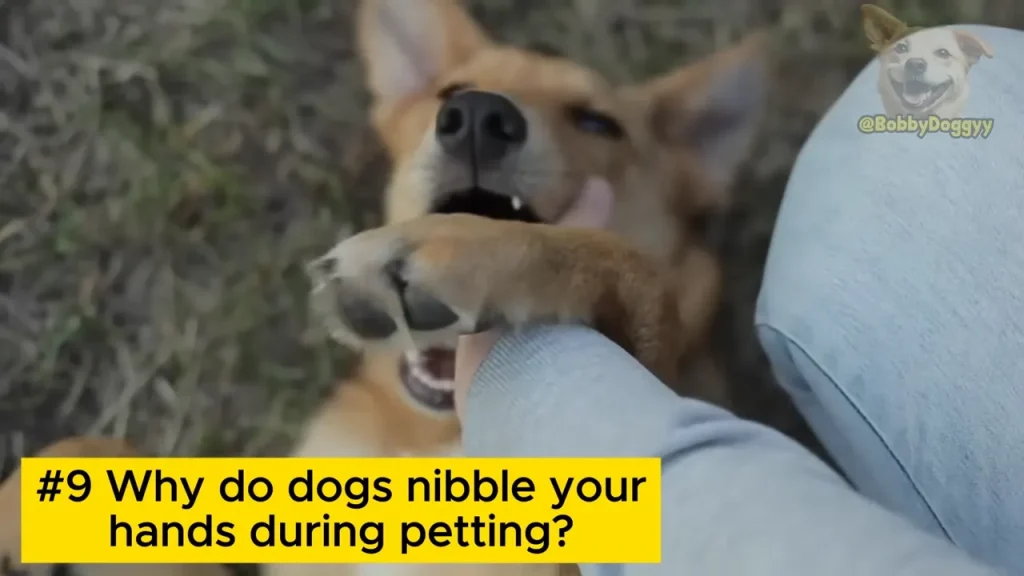
Ever been petting your dog, and they start gently nibbling at your hand? 🐾
When your dog gently nibbles your hands, they’re expressing affection and enthusiasm.
It’s not a bite, not aggressive at all… just a soft, gentle nibble.
It can be a little ticklish, a little surprising, and maybe even a little bit confusing!
But what does it mean when your dog nibbles you while you’re petting them?
Is it a love bite? A playful nip?
Let’s decode this gentle gnawing! 🧐
This behavior is common among well-socialized dogs, especially during puppyhood when they play by nibbling each other.
Think back to puppy play – all those playful nips and bites as they tumble and wrestle with their littermates.
Nibbling is a natural part of puppy play, a way they explore the world and interact with each other.
And guess what?
They often carry that nibbling behavior right into adulthood, especially with their beloved humans!
It’s a sign of good socialization, a throwback to those playful puppy days. 🐶
It’s like they’re saying, “I like this, keep going!”
Exactly! That gentle nibble is often a sign of pure enjoyment.
They’re loving the petting, they’re feeling relaxed and happy, and that little nibble is their way of saying, “Yes, this is the spot! Don’t stop now!”
It’s a positive reinforcement signal, canine style! 👍
However, boundaries are important…
However, it’s important to teach boundaries, especially if the nibbling becomes excessive.
While gentle nibbling is usually harmless and affectionate, it’s important to set limits.
If the nibbling becomes too hard, too frequent, or starts to hurt, it’s time to gently redirect your dog.
You want to encourage affection, but also teach them appropriate boundaries.
Providing appropriate toys can help redirect this energy.
If your dog starts to nibble too enthusiastically, offer them a chew toy instead.
This gives them a positive outlet for their chewing instincts and helps them learn to redirect that nibbling energy onto something more appropriate than your hands! 😉
Gentle nibbles are usually a sign of love and enjoyment, but teaching boundaries ensures those nibbles stay gentle and loving! 🥰
Barking at “Nothing”: Super Senses at Work!

Ever been perplexed by your dog barking seemingly at thin air? 🐕❓
Have you ever seen your dog barking at what appears to be nothing?
They’re staring intently at a blank wall, barking up a storm at… well, nothing that you can see or hear anyway!
It can be a bit baffling, even a little spooky!
Are they seeing ghosts?
Hearing things we can’t?
Losing their minds? 😂
Probably not!
There’s usually a perfectly logical explanation for this “barking at nothing” behavior.
And it all comes down to their super-powered senses!
Let’s tune in to the canine senses, shall we? 👂
While it might seem like they’re seeing ghosts, the truth is that dogs have much sharper senses than we do.
Their world is a symphony of scents and sounds that we humans can barely even imagine.
They can detect things we’re completely oblivious to, things happening far beyond our limited human perception.
Think of them as canine superheroes, with super-powered senses that put ours to shame! 🦸🐕
They can detect high-frequency sounds, distant smells, or even vibrations that we miss.
Yep, they can hear sounds we can’t, smell things miles away, and even feel vibrations in the ground that we’re completely unaware of.
That “barking at nothing” might actually be barking at something very real… just something we can’t perceive!
It could be a distant siren, a faint scent carried on the wind, or even subtle vibrations from underground.
Their senses are just that much more finely tuned than ours! 🤯
But sometimes, it’s not about super-senses…
Sometimes, barking at nothing is simply a way for them to release energy or express excitement.
Just like zoomies are a physical energy release, barking can be a vocal one!
If your dog is feeling pent-up, bored, or just plain excited, they might bark as a way to let off steam.
It’s like canine vocal exercises, a way to get those barks out of their system! 🗣️
However, if the barking is frequent and unexplained, observe whether they might be bored or anxious.
While occasional “barking at nothing” is usually no big deal, if it becomes excessive or seems to be accompanied by other signs of distress, like pacing, panting, or destructive behavior, it could be a sign of boredom or anxiety.
In those cases, it’s important to provide more mental and physical stimulation, and maybe even consult with a vet or dog behaviorist to rule out any underlying issues.
But most of the time, that “barking at nothing” is just your dog being a dog, using their amazing senses and sometimes just letting off a little steam! 😉
…And there you have it!
Just a sneak peek into the fascinating world of dog behavior!
- Secret to a Show-Stopping Maltese? Unleash Your Inner Groomer! – March 26, 2025
- 10 Hilarious Dog Memes You Need to See – March 24, 2025
- A New Leash on Life: Rocky the Gentle Giant Finds His Forever Home – March 23, 2025

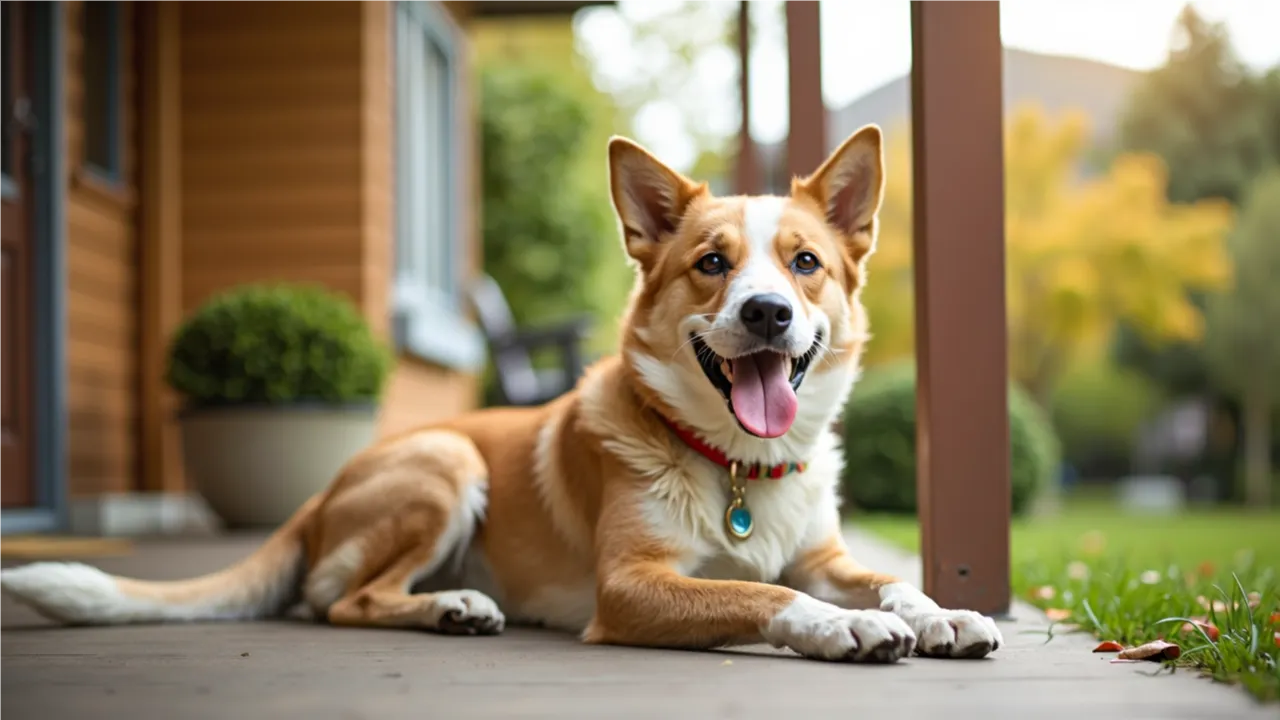
13 responses to “Decoding Doggy Behavior: 10 Curiosities Every Dog Lover Should Know”
how to order androxal cost insurance
how to buy androxal usa sales
generic enclomiphene canadian no prescription
buy cheap enclomiphene buy sydney
how to order rifaximin uk online
online order rifaximin new york city
cheapest buy xifaxan cheap online no prescription
buy xifaxan generic work
buy cheap avodart generic pharmacy canada
order generic avodart
how to get real staxyn
get staxyn generic from india
how to buy dutasteride generic from the uk
how to buy dutasteride generic a canada
flexeril cyclobenzaprine no prescription australia
how to order flexeril cyclobenzaprine generic online mastercard
buy gabapentin online gabapentin
how to buy gabapentin generic europe
levné kamagra levné
kamagra bez předpisu
acheter kamagra tabs france
acheter kamagra sur internet
discount fildena generic extended release
foreign drug purchase without prescription fildena
Buy itraconazole without a perscription needed
how to order itraconazole generic in usa